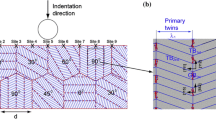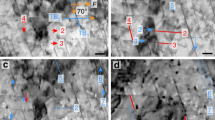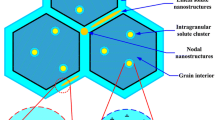Abstract
This study proposes a new elastic–plastic deformation decomposition algorithm for metal clusters to calculate micro-nanoscale elastic and plastic deformation gradients. In the macroscopic plasticity theory, the intermediate configuration is usually constructed by the dissection–unloading method. Because an atomic cluster is equivalent to a small element on a macroscopic object, our decomposition algorithm regards the unloaded configuration as the intermediate configuration for atomic clusters. This algorithm uses a new unloading method to obtain the unloaded configuration. This micro-nanoscale unloading method is constructed based on the principle of minimum potential energy and the embedded-atom method. Moreover, this method rigidly fixes atoms around dislocations during unloading. Therefore, the unloading process will not cause new plastic flow. Once the intermediate configuration is obtained, elastic and plastic deformation gradients are calculated by the interpolation method. Numerical examples of Cu nanowire stretching and bending show that the new decomposition algorithm can accurately and rapidly conduct the elastic–plastic decomposition of the total deformation. This algorithm provides a computational basis for multiscale coupling analysis of mechanical behavior of metal materials from the micro-nanoscale to the macroscale.
























Similar content being viewed by others
References
Lubliner J (2008) Plasticity theory. Dover Publications, Mineola
Khan AS, Huang S (1995) Continuum theory of plasticity. Wiley, Hoboken
Lee EH (1969) Elastic–plastic deformation at finite strains. J Appl Mech 36(1):1–6
Clayton J, McDowell D (2003) A multiscale multiplicative decomposition for elastoplasticity of polycrystals. Int J Plast 19(9):1401–1444
Clayton JD, Hartley CS, McDowell DL (2014) The missing term in the decomposition of finite deformation. Int J Plast 52:51–76
Chokshi AH, Rosen A, Karch J, Gleiter H (1989) On the validity of the hall-petch relationship in nanocrystalline materials. Scr Metall 23(10):1679–1683
Schiøtz J, Vegge T, Di Tolla F, Jacobsen KW (1999) Atomic-scale simulations of the mechanical deformation of nanocrystalline metals. Phys Rev B 60(17):11971–11983
Van Swygenhoven H, Caro A (1998) Plastic behavior of nanophase metals studied by molecular dynamics. Phys Rev B 58(17):11246–11251
Van Swygenhoven H, Spaczer M, Caro A, Farkas D (1999) Competing plastic deformation mechanisms in nanophase metals. Phys Rev B 60(1):22–25
Van Swygenhoven H, Caro A, Farkas D (2001) A molecular dynamics study of polycrystalline fcc metals at the nanoscale: grain boundary structure and its influence on plastic deformation. Mater Sci Eng A 309–310:440–444
Van Swygenhoven H, Derlet P (2001) Grain-boundary sliding in nanocrystalline fcc metals. Phys Rev B 64(22):224105
Yamakov V, Wolf D, Salazar M, Phillpot S, Gleiter H (2001) Length-scale effects in the nucleation of extended dislocations in nanocrystalline Al by molecular-dynamics simulation. Acta Mater 49(14):2713–2722
Yamakov V, Wolf D, Phillpot S, Gleiter H (2002) Deformation twinning in nanocrystalline Al by molecular-dynamics simulation. Acta Mater 50(20):5005–5020
Yamakov V, Wolf D, Phillpot SR, Mukherjee AK, Gleiter H (2002) Dislocation processes in the deformation of nanocrystalline aluminium by molecular-dynamics simulation. Nat Mater 1(1):45–49
Yamakov V, Wolf D, Phillpot S, Gleiter H (2003) Dislocation–dislocation and dislocation-twin reactions in nanocrystalline Al by molecular dynamics simulation. Acta Mater 51(14):4135–4147
Yamakov V, Wolf D, Phillpot S, Mukherjee A, Gleiter H (2004) Deformation-mechanism map for nanocrystalline metals by molecular-dynamics simulation. Nat Mater 3(1):43–47
Vo NQ, Averback RS, Bellon P, Odunuga S, Caro A (2008) Quantitative description of plastic deformation in nanocrystalline Cu: dislocation glide versus grain boundary sliding. Phys Rev B 77(13):134108
Nemat-Nasser S (1979) Decomposition of strain measures and their rates in finite deformation elastoplasticity. Int J Solids Struct 15(2):155–166
Stukowski A, Arsenlis A (2012) On the elastic–plastic decomposition of crystal deformation at the atomic scale. Modell Simul Mater Sci Eng 20(3):035012
Tadmor EB, Ortiz M, Phillips R (1996) Quasicontinuum analysis of defects in solids. Philos Mag Phys Condens Matter Struct Defects Mech Prop 73(6):1529–1563
Miller RE, Tadmor EB (2002) The Quasicontinuum method: overview, applications and current directions. J Comput Aided Mater Des 9(3):203–239
Rudd RE, Broughton JQ (1998) Coarse-grained molecular dynamics and the atomic limit of finite elements. Phys Rev B 58(10):R5893–R5896
Wagner GJ, Liu WK (2003) Coupling of atomistic and continuum simulations using a bridging scale decomposition. J Comput Phys 190(1):249–274
Weinan E, Engquist B (2003) Multiscale modeling and computation. Notices AMS 50(9):1062–1070
Eringen AC (1972) Nonlocal polar elastic continua. Int J Eng Sci 10(1):1–16
Eringen AC (1974) Theory of nonlocal thermoelasticity. Int J Eng Sci 12(12):1063–1077
Bessa MA, Bostanabad R, Liu Z, Hu A, Apley DW, Brinson C, Chen W, Liu WK (2017) A framework for data-driven analysis of materials under uncertainty: countering the curse of dimensionality. Comput Methods Appl Mech Eng 320:633–667
Liu Z, Bessa M, Liu WK (2016) Self-consistent clustering analysis: an efficient multi-scale scheme for inelastic heterogeneous materials. Comput Methods Appl Mech Eng 306:319–341
Li H, Kafka OL, Gao J, Yu C, Nie Y, Zhang L, Tajdari M, Tang S, Guo X, Li G, Tang S, Cheng G, Liu WK (2019) Clustering discretization methods for generation of material performance databases in machine learning and design optimization. Comput Mech 64(2):281–305
Mott PH, Argon AS, Suter UW (1992) The atomic strain tensor. J Comput Phys 101(1):140–150
Tian X, Cui J, Li B, Xiang M (2010) Investigations on the deformation behavior of polycrystalline Cu nanowires and some factors affecting the modulus and yield strength. Modell Simul Mater Sci Eng 18(5):55011
Mishin Y, Mehl MJ, Papaconstantopoulos DA, Voter AF, Kress JD (2001) Structural stability and lattice defects in copper: Ab initio, tight-binding, and embedded-atom calculations. Phys Rev B Condens Matter Mater Phys 63(22):2241061–22410616
Stukowski A, Albe K (2010) Extracting dislocations and non-dislocation crystal defects from atomistic simulation data. Modell Simul Mater Sci Eng 18(8):085001
Honeycutt JD, Andersen HC (1987) Molecular dynamics study of melting and freezing of small Lennard–Jones clusters. J Phys Chem 91(19):4950–4963
Aurenhammer F, Klein R, Lee D-T (2013) Voronoi diagrams and Delaunay triangulations. World Scientific Publishing Company, Singapore
Nocedal J, Wright S (2006) Numerical optimization. Springer, Berlin
Bower AF (2009) Applied mechanics of solids. CRC Press, Boca Raton
Nosé S (1984) A unified formulation of the constant temperature molecular dynamics methods. J Chem Phys 81(1):511–519
Stukowski A (2009) Visualization and analysis of atomistic simulation data with OVITO—the open visualization tool. Modell Simul Mater Sci Eng 18(1):015012
Acknowledgements
This work is supported by the National Natural Science Foundation of China [51739007] and the State Key Laboratory of Science and Engineering.
Author information
Authors and Affiliations
Corresponding author
Additional information
Publisher's Note
Springer Nature remains neutral with regard to jurisdictional claims in published maps and institutional affiliations.
Rights and permissions
About this article
Cite this article
Yu, Y., Cui, J. Elastic–plastic deformation decomposition algorithm for metal clusters at the atomic scale. Comput Mech 67, 567–581 (2021). https://doi.org/10.1007/s00466-020-01948-5
Received:
Accepted:
Published:
Issue Date:
DOI: https://doi.org/10.1007/s00466-020-01948-5




